I think we can all agree that injuries are never fun, but most of us have to deal with at least one at some point in our lives – especially exercise lovers like myself!
I’ve fortunately only had a few injuries thus far, but unfortunately, they’ve tended to be chronic issues that don’t go away easily. One of these injuries has been sesamoiditis, which I’ve been dealing with for several years now.
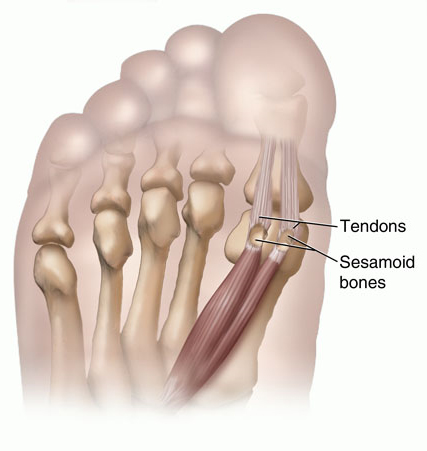
Sesame-what? you may be thinking. Simply put, we all have two sesamoid bones in each of our feet, and they’re tiny pea-shaped bones embedded in a tendon beneath the big toe joint. The sesamoids increase the leverage of the tendons that control the big toe, and a lot of pressure gets put on them every time the big toe is used to push the foot forward. When the tissues around the sesamoid bones become inflamed, the condition is called sesamoiditis.
I first experienced sesamoiditis after recovering from a torn calf injury 5 years ago, and I think it was the result of 1.) me chronically, subconsciously putting more pressure on my forefoot to take pressure off of my calf, 2.) me just naturally being a person that walks and moves on my toes. My mom always yelled at me about it growing up, random strangers have asked me if I was a ballerina, and my husband has the habit of walking up behind me and pushing me down by the tops of my shoulders!
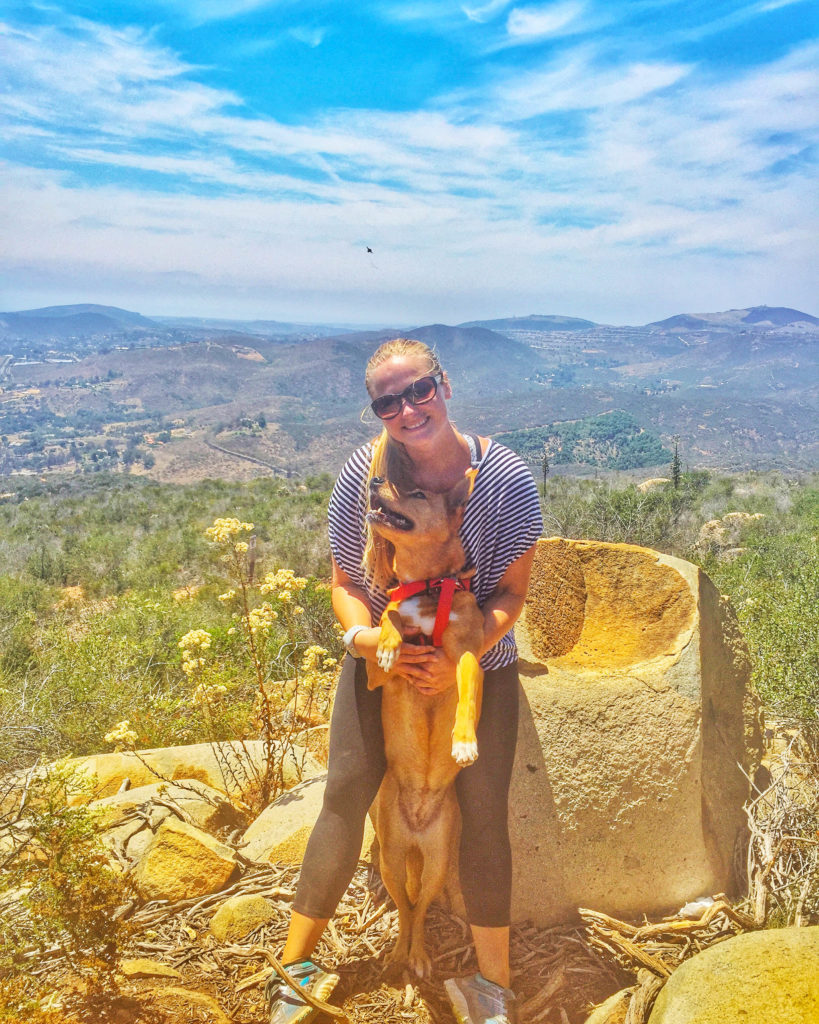
Hiking with my pup at Elfin Forest Recreational Reserve in Escondido, CA
I’ve shared posts about my sesamoiditis foot injury before, but realized that I haven’t talked about it in years when a reader recently emailed me asking me if I had any tips for dealing with the condition. I thought I’d share a post today highlighting how I’ve managed the chronic injury lately.
But first, a little bit of background in how I dealt with sesamoditis in the past:
When I got the initial sesamoiditis diagnosis, I used a walking cast for a bunch of weeks. This alleviated the aching pain I had been experiencing, but it eventually came back once I resumed normal workout activity. I also tried steroid injections to see if that would help, but didn’t notice any improvement.
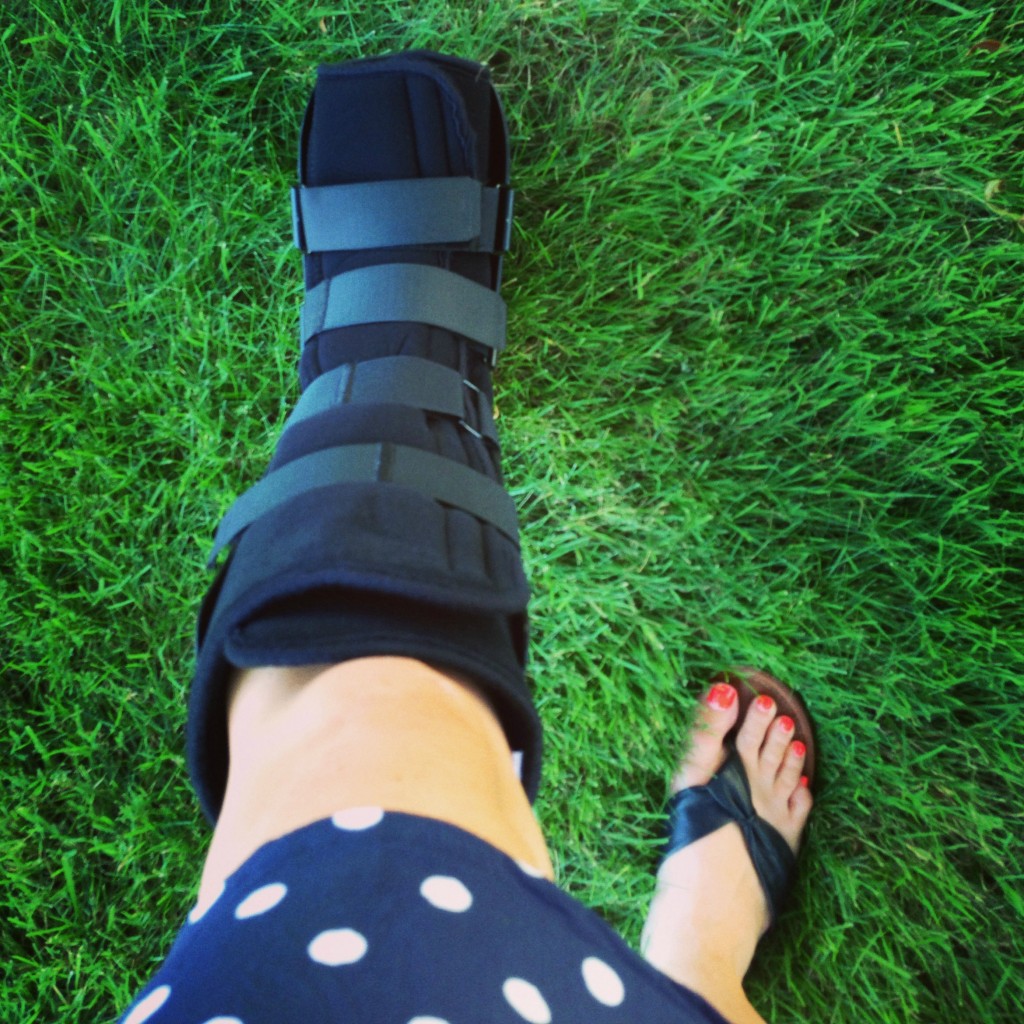
The lovely boot, circa 2013 when I first developed an issue with my foot
The last time I injured my foot was in 2016, and when I went to a sports podiatrist to see if anything was showing up funky in x-rays, he informed me that not only was one sesamoid bone damaged, both sesamoids were actually fragmented – “crushed” as he put it. Sometimes they’ll do surgery on a recurring sesamoiditis case, but in my case with both sesamoid bones breaking, they don’t recommend surgery due to the possibility that it might result in a foot deformity.
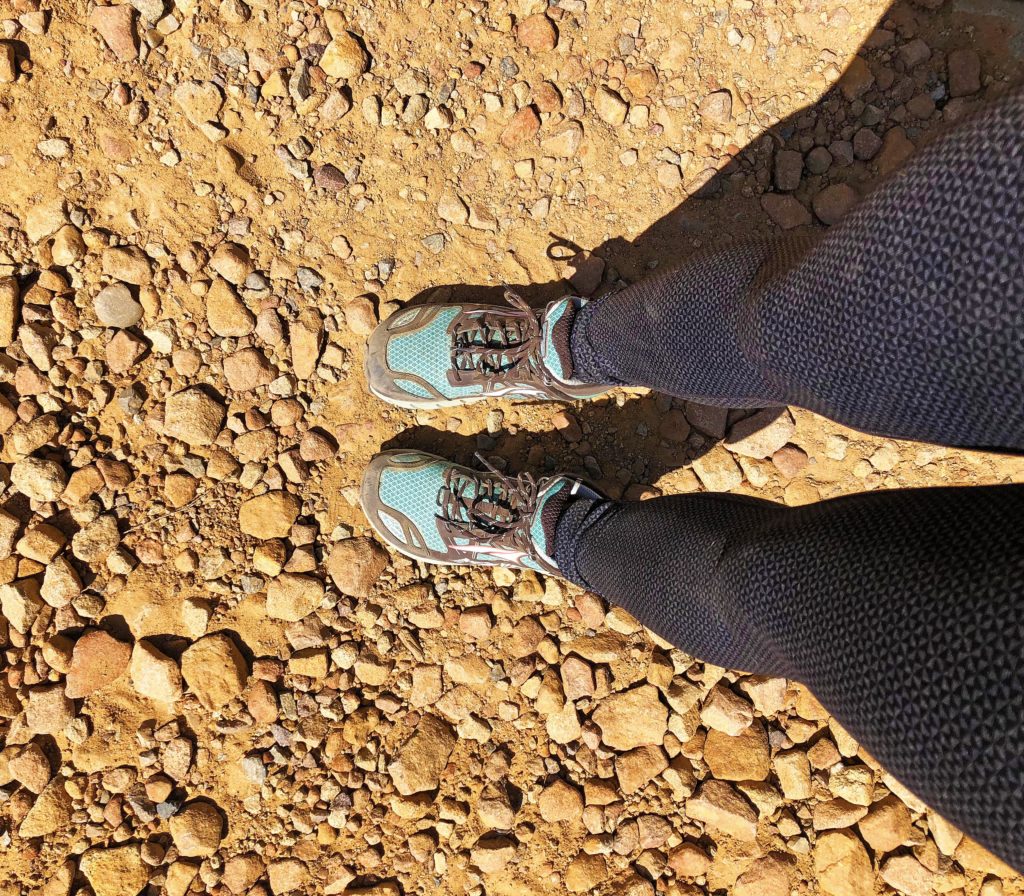
So, that’s where I was left a few years ago in dealing with sesamoiditis. I faced the fact that it was going to be a recurring issue for me if I wanted to continue my active lifestyle, and I committed myself to doing the 5 things that I’m sharing today. These tips have helped me to keep my sesamoiditis at bay. While it’s not completely gone and I do still feel that dull aching in my foot sometimes, the following things have helped me to manage it:
1.) Maintain a high/low impact exercise balance. I pay attention to how high intensity my workouts are, and make sure to balance them out with lower impact exercise so that I’m not putting too much pressure on my foot in a given week. That may mean that if I go for a hike one day, I’ll do upper body strength training the next day to give my foot a rest.
Post Update: Check out my list of fun, effective workout ideas for people with sesamoiditis. It features some of my go-to workouts!
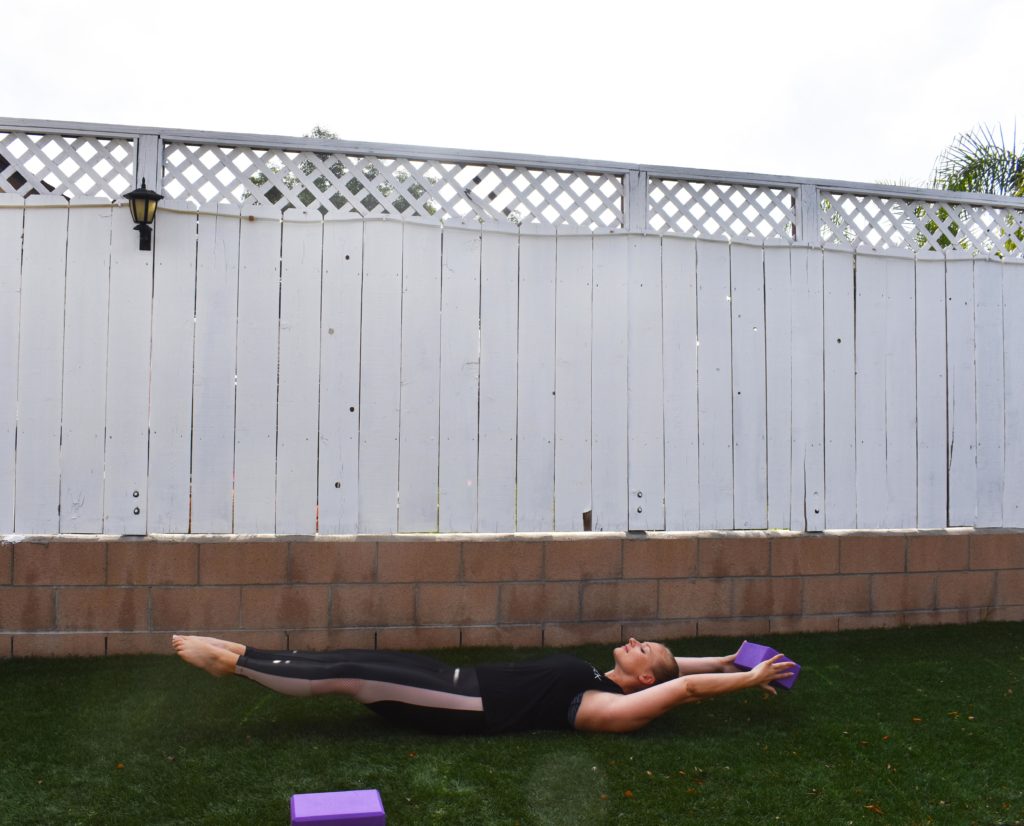
My favorite low impact workouts are yoga and walks with my dog at the beach.
2.) I get a deep tissue massage monthly that focuses on my calf and foot. I’ve been getting regular massages for a few years now, and it has absolutely helped me to keep my injuries under control. Since I believe that my foot injury has been related to my calf injury, I treat them both as areas to focus on. Every time I get a massage, I stress to the masseuse that I’m not there to just relax; I want any knots or tight spots from anywhere in my calf down through my big toe to be worked on with deep tissue (often uncomfortable!) massage.
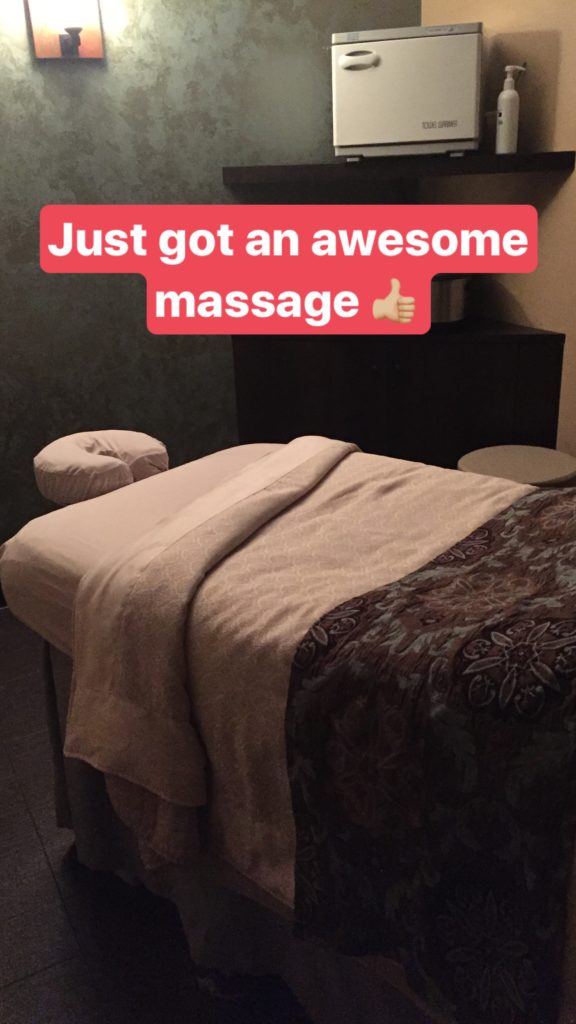
I know that you might not want to spend the money on what’s often seen as an “extra” thing every month, but honestly, nowadays I consider massages just part of my exercise recovery that is very much worth it!
3.) Make cycling my main form of cardio. Going along with the high/low impact exercise balance, I’ve found the types of cardio that work best for my foot injury: I limit the amount of plyometric exercise I do. In other words… not too much jumping around for prolonged periods! I’ve found that running aggravates it, which works out because I actually don’t enjoy running in the least bit. So I don’t run, at all, period. If I’m at boxing class and the instructor has me jumping around a lot, I’ll opt for a more low impact cardio move, like regular squats instead of jump squats. There is no shame in modifying moves to do what feels right to your body!
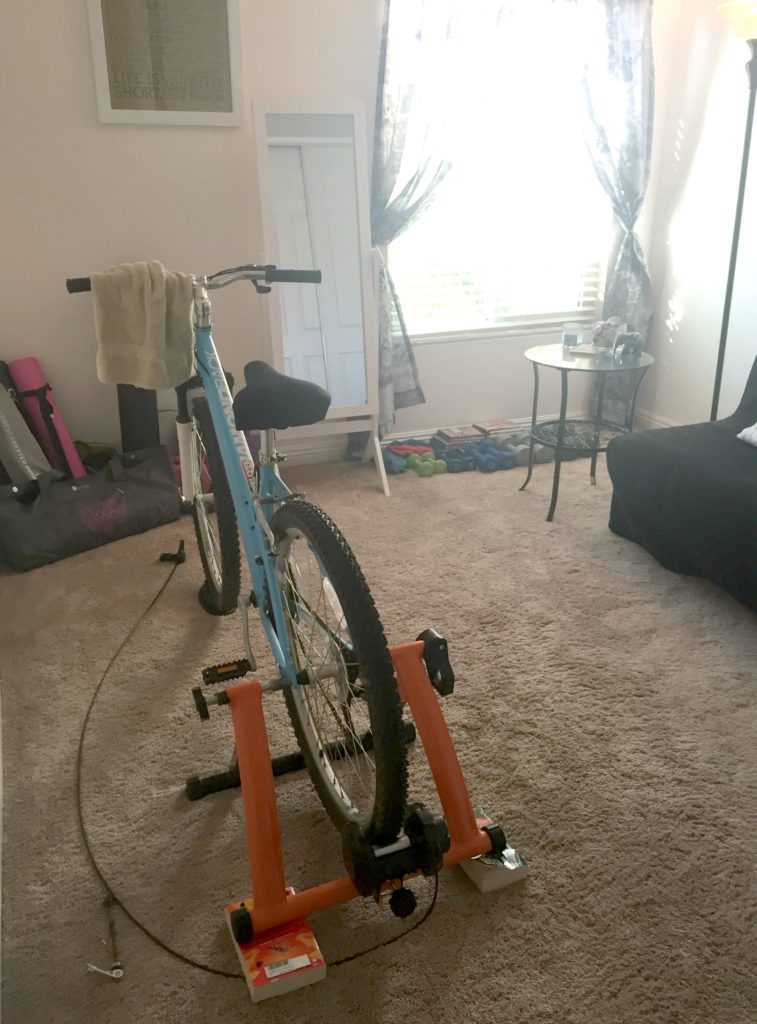
My at-home bike trainer
I’ve found that the cardio that seems to bother my foot the least is cycling, along with the rowing machine. I have a bike trainer at home that I use often for cardio workouts, and sometimes I’ll pop into cycling studios for a class. While I’ve had less access to a rowing machine lately, I’m hoping to incorporate it more into my exercise routine in the near future.
4.) I use a myofascial release massager on a daily basis. I received a Myobuddy massager as part of a blog campaign I did last year, and I’ve been using it on an everyday basis ever since! It’s a percussive massager that provides deep tissue, warming, trigger point and cutting edge vibrational massage – offering relief to muscle soreness and myofascial pain.
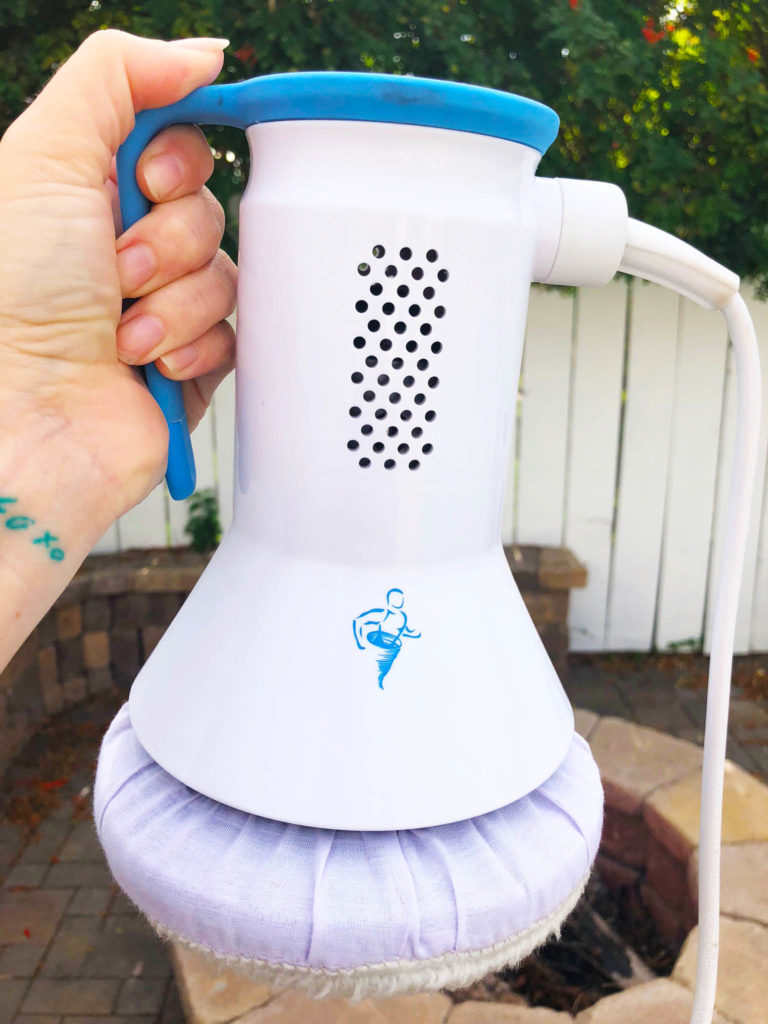
The Myobuddy myofascial release massager
I’ve found that the Myobuddy has helped to prevent foot soreness, as well as knots in my calf. It’s an easy way to work out the kinks in just a few minutes as I’m watching TV or chatting with my husband.
Check out more about the Myobuddy Massager Pro here.
5.) I wear a sesamoid foot pad during workouts. I started wearing a sesamoid pad underneath my sock last year, and the pad gives the big toe area where our sesamoids are a bit of a cushion. I’m not sure if it has been making a huge difference, but I do think it helps a bit.
Having sesamoid issues is a pain in the butt, but implementing these techniques has helped me to keep up with my active lifestyle while preventing myself from being in throbbing pain while laying in bed at night – so I consider it a win!
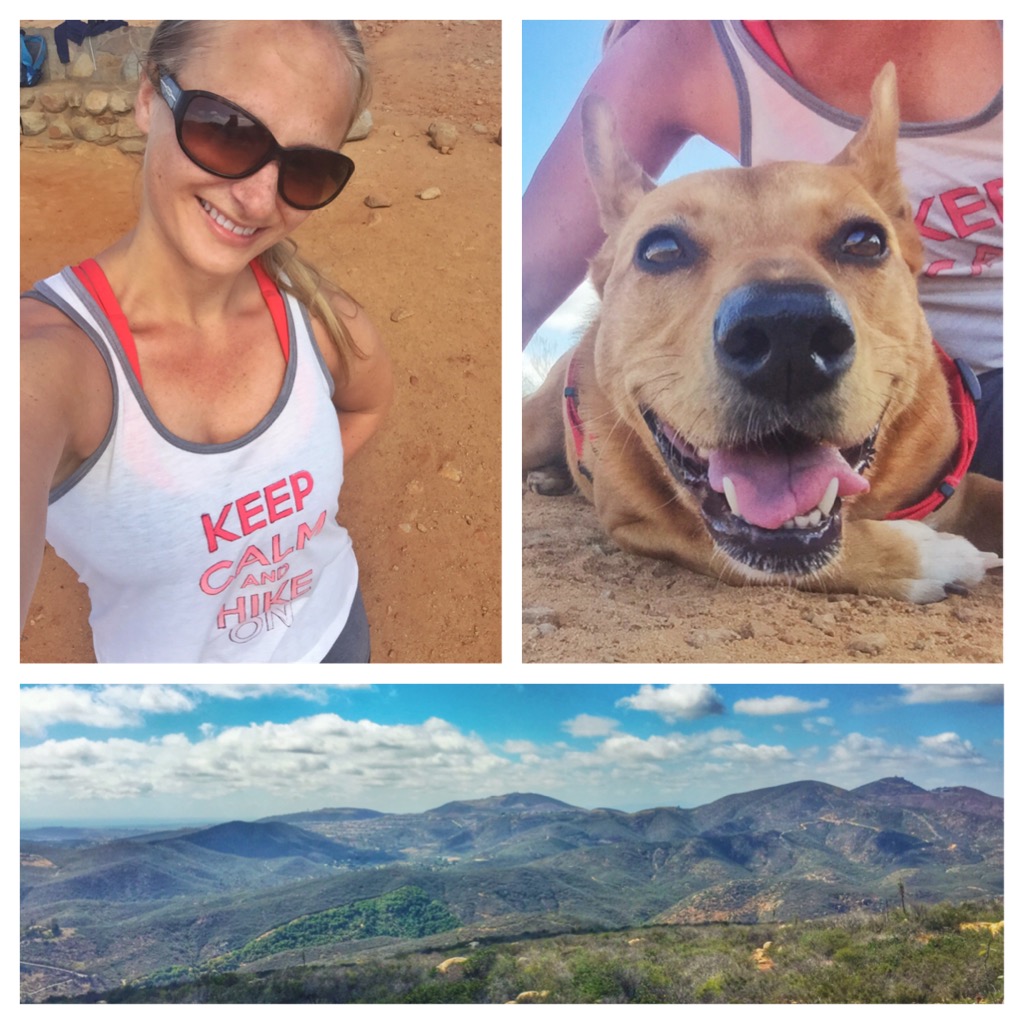
Unfortunately, my home is not currently injury-free, because my dog was limping a few weeks ago, and when I took her to the vet to see what was up, I found out that she tore her ACL. Luckily it’s only a mild tear so we probably won’t have to do surgery. I’ve been giving her anti-inflammatories, pain relievers and sedatives, just started feeding her a more natural turmeric supplement for healthy joints and tendons, and most importantly, I’ve been trying to have her rest it – which is no easy feat for a high energy pup!
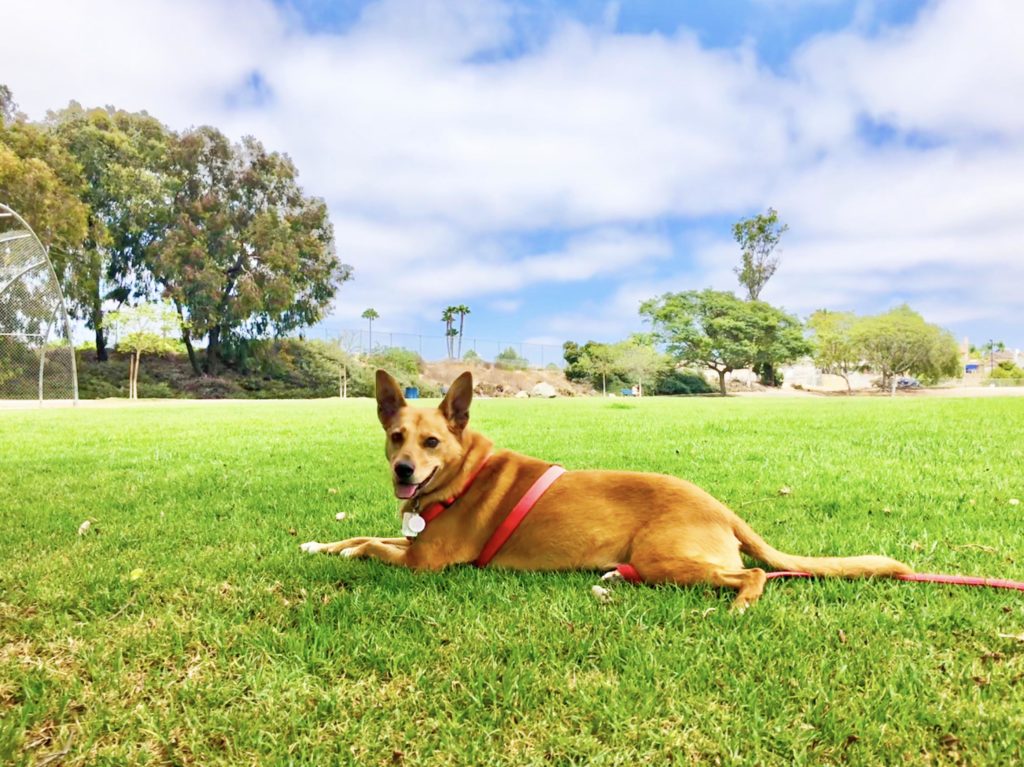
My happy patient
She’s got this puppy-like energy at almost eight years old, and I feel bad when she goes to sprint around and I have to insist on her calming down. Her having such a fun, crazy spirit is one of the things I love most about her! But, besides a few sprints that she’s snuck in, including one incident where a cat was chased in my front yard, she has been doing really well. She actually hasn’t limped since a day or two after her diagnosis, so hopefully in a couple more weeks we’ll be in the clear. Even though she’s a whiner when it comes to things like being in the car and recovering tennis balls that rolled under the couch, Harley is really being a trooper about this ACL tear!
Tell me.. Are you dealing with any nagging/longterm/chronic injuries? What’s the worst injury that you’ve had?

Injuries are the worst, and I’m starting to get more and more as I get older (I’m getting over a knee sprain right now!). I’m going to need physical therapy and will have to watch it from now on. I’m sorry to hear about your sesamoiditis (which I’ve never heard of) — these are great tips that I’m sure will help a lot of people!
While I have not heard of this specifically, all of my injuries are calf and foot related as well. I do lots of these same things to keep myself healthy and running. Good luck to you!
The timing of this post is so funny- we walked almost 9 miles our first day in Dublin and now my left foot is killing me. It’s mostly the outer edge so I don’t think it’s the same thing you have but man is it annoying! I should go get a massage and tell Brandon it was for medical purposes. 😉
Again, I’m so sorry to hear about Harley but am slightly relieved that it’s a mild tear. Hopefully the meds and restricted exercise help her heal back to normal!
Interesting. I must admit that I’ve never even heard of sesamoid bones, but I can see how they would be incredibly painful if they are inflamed…or crushed. It’s interesting how many injuries occur because we’re trying to relieve pressure on other injured parts. Sounds like you’ve figured out how to manage though! Sesamoid socks is a cool concept! Also, poor Harley. Our neighbor’s pup recently had to have surgery for an ACL tear, so I know how hard that is on big dogs who like to run a lot. Tell Harley to hang in there!
Thanks for sharing!
I’m 9 months into disability from my fractured sesamoid and chronic tears of the surrounding tendons. The chronic bit and continuing to try to function through the 7 weeks of misdiagnosis made it harder to get the inflammation under control. I have learned through trial and error that I agree with all of you suggestions with one of my own to add. Hoka shoes have been a huge help to me, to low rise, assistance with rocking motion and stability they provide have helped tremendously!
Ooooh, thank you for the shoe suggestion! I will have to check them out.
Wishing you luck in your recovery! Mine has been feeling pretty good, although I have to say that wearing heels over the holidays made my foot pretty sore for a couple of days. It seems that it’ll never be really gone, but being able to keep it under control has definitely helped!
Hoka shoes have helped me a lot with my sesamoiditis too, especially in combination with podiatrist orthotics. Still looking for a complete solution though… 🙁
Thank you for this! I’ve been struggling with this for the past 3 years and it’s been a nightmare. Mine was brought on by running a half marathon and having poorly designed feet! I’ve had innersoles, air boot and Monday I have a steroid injection. It just won’t seem to go away and I’ve become so unfit over the last few years due almost every exercise aside from weights bringing on throbbing pain all night afterwards.
Sorry to hear you have a similar thing but it’s also good to read about your experience, it’s hard for people to understand the injury since most people don’t even know what a sesamoid is!
I’m sorry to hear that your sesamoiditis has become such a barrier to you living an active lifestyle! It’s a frustrating injury, but I hope that you find ways to better cope with the pain. Lately my sesamoiditis has been really good & I’m sticking to workouts that I know don’t aggravate it.
You have no idea how amazing it was to read this article. I have been struggling with this for the past year and I have become so frustrated and defeated because nothing I have done has seemed to help in the slightest. If one more doctor tells me to take Advil or ice it or wear a pad I’m gonna scream lol. I haven’t been able to wear shoes other than sneakers with inserts in them for the past year. Is there an end in sight? How do you wear any type of shoe with a heel on it? Did you try any laser treatments or physical therapy? So sorry you are dealing with this chronic issue as well <3
Thank you, Amanda! Ugh, I feel your pain… and I hope that you find the things that help you keep your sesamoiditis under control too. I will tell you that I rarely have nagging pain in my sesamoids these days, and as I mention in the post, it really only comes back if I overdo it. For instance, if I go for a 10 mile hike, I can bet that it’ll be sore for a few days. As far as shoes go, this is one of those things… If I wear heels, chances are good that my foot will be a bit sore the next day. I try to minimize this by only wearing heels that are somewhat comfortable and not on too crazy of an angle. I did not do laser treatments and I already knew a lot of physical therapy exercises from doing PT for my calf multiple times, but if you’ve never done PT it might be a good idea. It definitely can’t hurt! Best of luck to you with the injury!
Thank you for sharing this! I have a very similar story. Overuse that eventually led to a walking boot. I’ve been out of the boot for just a few days now. It’s such a strange injury. What type of sesamoid pads do you use during workouts? A simple pad, or more of a J-shape to offload the weight onto the rest of your foot? Have you done any custom orthotics or are there insoles you could recommend? Have you done any of the electric pulse massagers? Thank you!
Apologies, I missed this comment until now! It is indeed a really weird injury. Nowadays I don’t wear a foot pad at all, and my foot has not been bothering me at all – I think because I haven’t been overusing it (life with a newborn is mostly only leaving me time for shorter workouts & walks!). I really do think for me, rest & not overdoing it is the key with it. When my foot has bothered me in the past, I have used myofacial massagers that help a bit as well. As far as foot pads go, I had tried 2 kinds: 1 padded the sesamoid, and the other sort of padded the rest of the foot to position the sesamoid a bit off the ground.
Wishing you luck with your foot pain!
100% try on Vibrams, those shoes with 5 toes that look super funky? Those 100% take away my sesamoid issue, the only problem is I can’t really wear them to all worksites…
That’s so interesting – doctors have told me that wearing shoes with little to no support makes sesamoid issues worse!
Amidst COVID quarantines, I have not had a massage since January and that is DEFINITELY one thing that keeps my foot and calf issues at bay. Both have been so tight and sore, and I can’t wait to have a masseuse work out the knots!
Hi there! I got “injured” my stepping on a small piece of glass that went into my big toe and hit a nerve. Due to the pain I lifted my toe and walked on hard wood floors for weeks. I ended up getting sesamoiditis (without a fracture) really bad. I was in a walking boot for 7 weeks combined with a sesamoid pad and taping. I’m now not doing either and wearing a Hoka Bondi shoe, but my Physical therapist I think might be doing some harmful exercises for someone who has sesamoiditis. I feel like I’ve gone backwards in the last several weeks. Did you happen to go to PT for your injury?
Sorry for my delayed response – I missed your comment initially. Yes, I went to PT for a combo of my injured calf + sesamoiditis. I think with a lot of foot issues – ours included – it really is a lot about how you’re continuously walking/hiking/running/putting pressure on the feet. For me, I definitely have a tendency to be more on my toes, which puts more pressure on the sesamoids. For you, it sounds like you had that added toe area pain with trying to overcompensate from your glass injury. It really is such a hard injury to treat & heal from!
I am sure I have sesamoiditis under my left toe. I also have an incredibly painful fungal infection in the same toenail (left big toe), and now my left knee is bothering me all the time because I am probably not walking properly to keep the pressure off the sesamoid bones. I’m completely bummed out. I’ve been thinking that I’m going to have to have surgery, although I dread it. I have had minor arthritis in my knees for 15 years, but it never stopped me from being very active. And now my left knee is painful all the time and I have to wear a brace. I still haven’t had an xray though I am supposed to next week. I take tumeric and diatomaceous earth for the fungus, plus an antifungal cream. I do ride a bike in the house, but I would be interested in feedback on surgery, etc. All the suggestions in the blog above I will incorporate. I really don’t want to have surgery.
Hi Annie! I’m so sorry to hear that you’re experiencing pain in your foot and knee. Of course surgery would not be ideal, though sometimes it’s necessary… They may recommend physical therapy to retrain your body with how you’re moving it – I think PT helped me realize that I was putting extra stress on my foot. If you haven’t tried the things that I discuss in this post to help your toe pain, I would definitely suggest that you start doing them. It can’t hurt, and could possibly give you some relief. Good luck!
I have had sesamoiditis in my right foot for the last eight years. I wish I had known what it was back then, it’s only been the last year or two that I’ve learned what it actually is. I’ve had the injections, orthotics, seen an Orthopedic surgeon and now onto third podiatrist. The pain is now also going to the other foot. I have bi partite sesamoids in both feet which means the second sesamoid is split into two. If this lot of orthotics does not work I will have to consider surgery to remove it. The orthotics used to help but not anymore. So bad now that even walking around town and then at work for three days is enough to make it so bad I can hardly walk. Using ice on the pain does help a lot. I have bought a moon boot to have on hand for when it’s really bad. So disheartening as my fitness is really non existent now. I’m looking at buying either a spin bike or an upright bike for aerobic fitness, any thoughts on which would be better? Thank you
Hi Leigh! I’m so sorry to hear that you’re having such a rough time with your feet. It’s wild that you now are having the same issue in both feet! That makes me wonder if you naturally put more pressure on the ball of your feet.
For the last few years, I’ve used a spin bike at home. I find that it puts minimal pressure on the feet. I personally like a spin bike better than upright because it’s a better workout – gets my heart rate up easier, and I like the ability to periodically stand up while pedaling.
Hello,
I found reading your story encouraging as I have sesamoiditis. I had surgery on my left foot in January to remove a lump under the 4th metatarsal and during recovery I walked a bit on my left big toe to alleviate using crutches and walking on my heal both of which which were hurting. I didn’t realise I had pain in my big toe until weeks later when the scar healed from the surgery and I could feel the specific area of pain in my big toe. I have been very upset to read that recovery from sesamoiditis is complicated, long and not guaranteed. I am currently trying to find ways to heal it. I use insoles in slippers for around the house, and in one pair of Sketchers boots which I had and seems to be the most comfortable as it has the lowest heal. I have been given toe/feet exercises to do which have helped the toe loosen up. I have bought an ultra sound device and use that daily, and have bought an exercise bike for the house, but not used yet.
My biggest challenge however is the mental one. I retired from a 40 year career and went straight to surgery to remove a lump which appeared in my foot. This caused the 4th metatarsal to ‘drop’ and I now need surgery to cut and pin this as it currently is too low and pushed out through the bottom of my foot. Now I also have sesamoiditis in the same foot. The surgery will require non-weight bearing rest for 4-6 weeks, so I know I will not be able to do the exercises I have just got underway to help the sesamoiditis. To top it all I have a torn shoulder ligament and I am awaiting surgery to repair this, once I have recovered from this foot surgery and then this will hinder recovery even further. How have you coped mentally? I find the evenings before bedtime the worst as I can’t look forward to the next day as I know the condition will be there again in the morning.
I’m so sorry to hear that you’re going through a lot. I’m sure this is not how you pictured the beginning of your retirement! It is very challenging having a chronic issue like sesamoiditis – as you said, not just physically but mentally too. Looking on the bright side, if you are soon going to get food surgery and will have to be resting, chances are good that your sesamoiditis will improve since it’s an overuse injury. This is what I’ve experienced when forced to rest, at least.. When I gave birth and was only doing gentle exercise for the first few months postpartum, my foot felt great!
One idea to help you cope mentally is to get a gratitude journal that you write in for a few minutes each morning. It could help you to focus on goals you have for the day and things you’re thankful for, and help you set a positive intention for the day. You can only control what you can control, so focusing on the aspects of life that you have the power to change today can help you feel less down about your injuries. Hang in there, Andy!
Hi I found out last year while doing 3 marathons in 18 months at 54 ( not planned – just due to Covid and London Marathon being rearranged).
I haven’t got fractures but inflammation. The arch of my foot hurts mainly.
I am a runner and while I am still working I really don’t want to stop….but am worried. When u retire and I have more time in 5 years I am happy to walk more, as I will have more time. I have a rowing machine and spin bike in my home gym. But running is sooooo good for my mental health with the type of job I have.
To manage
I have massages every 2 weeks
Stretch my calves 3x a day every day
Stretch calves after every run (3x a week)
Have reduced mileage to 16-20 miles a week
Have a TENS machine
Introduced strength training x3 per week
My question is….what exercises will strengthen my feet….Read about walking barefoot on heels then toes 20 times for 5 sets is good, but it means going up on your toes which seems like a bad idea….views ? Suggestions?
Hi Mandy! Wow, 3 marathons in 18 months! That’s awesome, but it does sound like you’ve got pain from overuse on your hands. Have you tried letting it rest for a couple weeks or only doing low intensity exercise for a month? I know it’s tough when you’re as active as you are, but I’ve found that resting definitely helps if my foot is feeling inflamed.
I did a lot of foot strengthening exercises while in PT, and I have to say that for me and probably a lot of other healthy, strong people that have sesemoiditis like you, it’s not a weakness issue. It’s an overuse issue. The regular calf stretching that you’re doing is great, but have you tried doing foot stretches? One idea is to get a small therapy ball that you can “roll” out your foot on. You can also look on YouTube for stretches/yoga poses that stretch out the feet.
Thanks. I point my toes down and up evert day lots of times…..and roll my foot on my yoga ball but always find it counter intuitive to put pressure on the base of my feet where the pain is!
Will look at foot strengthening exercises.
My mental health depends on exercising outside ….I am doing much lower mileage than I was.
Mine is more if an ache versus any pain.
That’s interesting because mine is more of an ache when it flairs up as well. That almost makes it worse because then it’s easier to ignore it!
I completely understand that exercising outside improves your mental health. You don’t want to give it up, and nor should you have to! Lower mileage is probably your best bet. Do you ever do strength training at the park? Lunges, squats, tricep dips on a park bench, etc… could be another way for you to get in outdoor workouts without aggravating your foot!
Really thankful for you sharing your story! I just got an MRI scan taken last week after having had pain for month. My physio told me in March that he thinks it’s something with the sesamoid, but to get the appointments for x-rays and mri takes enormously long where I live. I still haven’t gotten the official results from the hospital here, but sent the scans to a old friend in Germany who happens to be a radiologist. He told me I have a sesamoid fracture, fluid around the bone which points to a sesamoiditis and a tendonitis, as well as way to much pressure on my ither four toes, most likely due to wrong form to be able to walk without feeling the pain under the big toe.
Anyway, I guess I’m going to have a long way ahead of me. I hike, run, ski and dogmush which are all things that upset the sesamoid. Really hope to find a way to deal with this and continue with my activities once I’m allowed to use the foot again. I’m glad to see so many find ease in wearing Hokas, but I wanted to mention that for me the pain started the day I changed to Hoka shoes to run last September. I guess it just shoes how different our feet all are.
How is your pain now? Can you do everything like you did before?
Sara, I’m sorry to hear that you’re suffering from a sesamoiditis issue! I think you’ll find that you’ll still be able to do your favorite activities, but you may need to approach your active lifestyle a bit differently. You probably need to give yourself a good rest to recover initially. Once you resume exercise, you may need to adjust how you do things – at least that’s what I’ve personally experienced.
What I’ve learned is that listening to my body is key… rather than just trying to push through even if my foot is hurting! Overall I feel good, though sometimes my foot will flair up. For instance, I was on vacation earlier this year and walked all over the place in flips flops.. bad idea! But when it comes to my workouts, I’ve adjusted and cut out certain things that I know aggravate it. For instance, I still do kickboxing, but I don’t jump around in between moves because too much plyometric exercise definitely bothers my foot.
PS – That is interesting about the Hoka shoes! Exactly, every body is different.
I have been dealing with Sesamoiditis for a few years. My podiatrist says massage will help. Has anyone used an electric foot massager for sesamoiditis? I would love to get one but do not want to do further harm. And there are so many out there, I have no idea which one to try.
I’ve absolutely found that massage helps! My foot tends to be so tight and massage helps to loosen it up. I currently have a Theragun, and have owned other percussive massagers like the Myobuddy in the past.
I am late to the party on this one but was looking for some cardio options since I have a sesamoiditis flare up right now. I actually discovered these inconvenient little bones years ago when I broke one of them and kept running on it for eight months. Long story short, after a year of bone stimulation, PT, and a surgery, the broken sesamoid was still not healing and still hurting. One thing I suggest anybody with broken sesamoid to try is a high quality ankle brace. I used one when recovering from my surgery because I just felt like I needed it and the pain was completely gone from the sesamoid. Turned out I actually had severe ankle laxity that was the root of my knee and hip problems for years before. May not be the same situation for everyone but I highly recommend trying the brace just to see what happens!
Like you, I learned to love cycling and have had two ankle reconstructions to fix all my other issues. It’s been a long road and I still can’t really run like I used to but it doesn’t stop me from trying. LOL
Wow! That’s so interesting. From my own experience and everyone that I’ve spoken to with sesamoiditis, there seems to be a few commonalities: 1.) There’s usually another root cause for the foot issue – like in my case the calf, or in your case the ankle. 2.) Sesamoiditis seems to happen to extremely active people. We don’t like to stop moving, even if our foot injuries try to slow us down! 🙂
I’m so glad I found your blog. I have been dealing with this injury for three months. Previously I did a lot of indoor cycling and unfortunately find cycling to flare my foot. I’m so depressed with this and have not found any relief. MRI shows no fracture just osteoarthritis in the sesamoid as well as a toe ligament sprain (turf toe). I’ve tried the boot however I find it uncomfortable to walk in. I am trying the dancer pads but they also hurt my feet after all day of walking on them… I’m so over this . I plan on taking a month off and just swimming daily. Praying this injury heals so I can resume walking and daily activities. Has anyone tried carbon fiber insoles? They look like they would be uncomfortable but I might try them to stabilize my toe. I have been taping my toe using the spica tape technique. This is helpful some days and worth a try if anyone is struggling with similar issues.
Thanks for the ideas. I agree that the boot is not comfortable at all. Swimming should be great for getting in exercise while also putting no pressure on the feet! How is swimming working out for you?
Just got diagnosed with sesamoiditis and found your blog. It has been very helpful! A question though…do you/did you stop high impact workouts all together? I like HIIT but I think that might have something to do with the seasmoiditis. Lunges are out, as are calf raises, but I’m wondering about jump squats (as you mentioned) and other plyometric movements or if I should just stop those completely. I’m already modifying my lower body strength routines. I’ve been wearing a pad during the day but it’s nothing like the pad you linked.
Anyways – the diagnosis was a week ago. I have not been icing (I know, I know) but I have been taking ibuprofen. I’m just really wondering if I need to stop all high impact activity…which would suck but I understand.
I totally understand your hesitancy to stop HIIT all together, I was the same way! Here’s what I’d recommend: Give up plyometric exercises (aka anything that involves jumping and landing on your foot) JUST FOR THE TIME BEING to let your foot rest. Maybe around a month. Once you are feeling less pain/hopefully no more constant pain, add a bit of HIIT back in and see how you feel. What I’ve found is that I can do high impact moves, but not an entire 45 minute high impact workout because the next day my foot will be sore. I like to sprinkle in plyometric moves like jumping squats with lower impact moves that put less stress on the foot/lower body all together. This seems to work well for me, but test it out and listen to your body. See how you feel once you add a bit of high impact exercise back in. Good luck, and get that icing in! 🙂